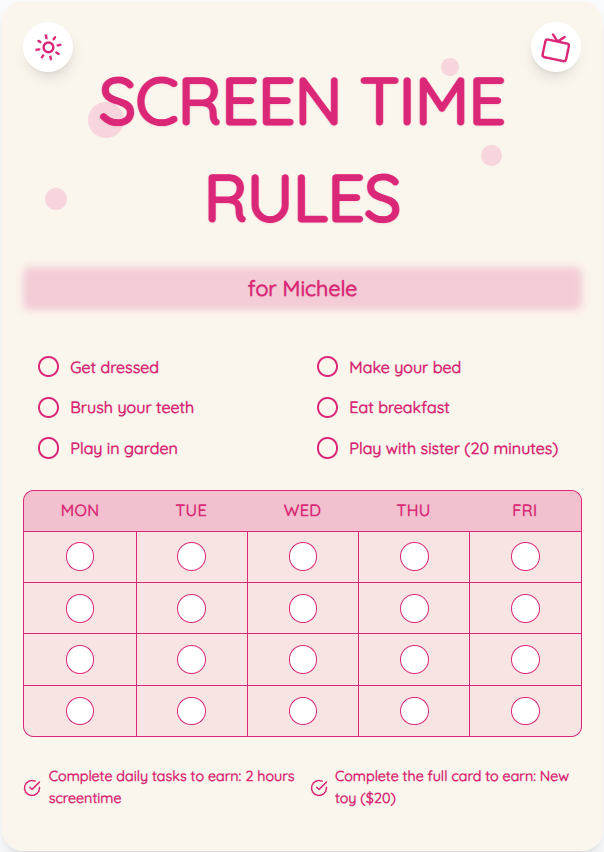Setting Screen Time Limits for Children: A Guide for Parents
As a parent, managing your child's screen time can be challenging yet crucial for their development. Find practical tips and expert advice on establishing healthy screen time limits for children aged 2-12.
See What Your Screen Time Chart Will Look Like
Here's an example of a beautiful, customizable screen time rules chart you can create for your family

Why Screen Time Limits Matter
Excessive screen time can impact children's physical health, sleep, behavior, and cognitive development. Setting limits helps promote a balanced lifestyle and encourages other enriching activities.
Effective Strategies for Managing Screen Time
Create a screen time schedule, use screen time charts as visual aids, involve kids in setting limits, encourage outdoor play and hobbies, and lead by example with your own screen habits.
Put These Tips Into Action
Create a custom chart to implement these strategies with your child
Balancing Educational Screen Time
Not all screen time is created equal. Prioritize educational apps, shows, and games that promote learning and skill development. Use screen time charts to allocate time for educational content.
Healthy Screen Time Alternatives
Explore alternative activities like reading, arts and crafts, family game nights, outdoor adventures, and imaginative play to reduce reliance on screens. Make these options easily accessible and engaging.
Practical Tips for Success
- Create a consistent screen time schedule
- Use a screen time chart to visually represent limits
- Set clear rules and consequences for screen time
- Encourage physical activity and non-screen hobbies
Frequently Asked Questions
How much screen time is appropriate for children?
The American Academy of Pediatrics recommends limiting screen time to 1-2 hours per day for children aged 2-5 and ensuring that screen time does not interfere with sleep or physical activity.
What are the benefits of using screen time charts?
Screen time charts provide a visual representation of allotted screen time, making it easier for children to understand and follow limits. They also promote consistency and help parents track usage.
How can I handle resistance to screen time limits?
Communicate openly with your child about the reasons behind screen time limits. Involve them in setting reasonable boundaries and offer positive reinforcement for following the rules.
Should screen time be allowed before bed?
Avoid screens at least an hour before bedtime as the blue light emitted can disrupt sleep patterns. Encourage wind-down activities like reading or relaxation instead.
By implementing these practical strategies and tips, you can create a healthy balance between screen time and other activities in your child's life. Visit ScreenTimeRules.com to generate personalized screen time charts and start managing screen time effectively today.
Ready to Transform Your Family's Screen Time?
Join thousands of parents who have successfully managed screen time with our customizable charts.
